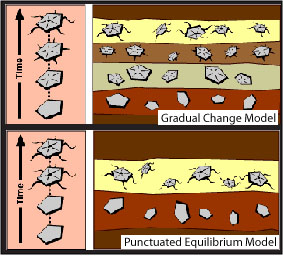Gradual Change Vs. Punctuated Equilibrium

Charles Darwin
believed that evolution was a slow
and gradual process.
He did not believe this process to be
"perfectly smooth," but rather, "stepwise," with a species evolving and
accumulating small variations over long periods of time. Darwin
assumed that if evolution is gradual then there should be a record
in fossils of small incremental change within a species.
But in many cases, Darwin, and scientists today, are unable to find
most of these intermediate forms. Darwin blamed lack of
transitional forms on gaps in the fossil record, a good assertion,
because the chances of each of those critical changing forms
having been preserved as fossils are very small. However in 1972,
evolutionary scientists Stephen Jay
Gould
and Niles Eldredge proposed another explanation for the numerous gaps
in the fossil record. They suggested that the "gaps" were real,
representing periods of stasis in morphology. They termed this
mode of evolution "punctuated equilibrium."
This means that species are generally morpholgically stable, changing
little for millions of
years. This leisurely pace is "punctuated" by a rapid burst of
change that results in a new species. According to this idea, the
changes leading to a new
species don't usually occur from slow incremental change in the
mainstream population of a species, but occur in those
populations living in the periphery, or in small geographically
isolated populations where their gene pools vary more widely due to the
slightly different environmental conditions where they dwell.
When the environment changes, these "peripheral" or "geographic
isolates" possess variation in morphology which might enable them to
have an adaptive advantage, leading to greater reproductive success.
These new successful morphotypes spread through the geographic
range of the ancestral species, appearing as a new morphology where
once the older forms were present.
Content
(http://www.pbs.org/wgbh/evolution/library/03/5/l_035_01.html)
Photo (http://evolution.berkeley.edu/)
